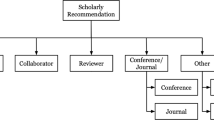Abstract
Social networks have experienced exponential growth in membership and have become a hotspot for research in recent years. It helps users manage relations by establishing new relations and maintaining existing relations. On the basis of social networks’ research, to encourage communication between scholars and facilitate management of academic information and academic relations, we built the Scholar-Oriented Social Network Cloud (SOSN) that is an academic information-centric social network. SOSN extracts academic information from various web sources on the Internet, and provides an application model for the social interaction and the semantic description of all related information. SOSN works as follows. Firstly, an academic search cloud is created that can provides academic search services according to users’ web context. Then SOSN extracts public academic information from various literature databases and search engines on the web using the academic extracting services; secondly, SOSN devises an application model in the domain of scholar social network, which is used to represent the complex relations of entities in the Scholar-Oriented Social Network Cloud; thirdly, based on FOAF (Friend of a Friend), MarcOnt ontology, FRBR (Functional Requirements for Bibliographic Records) and SWAP (Scholarly Works Application Profile) academic semantic project, SOSN defines Scholar, AcademicWork, AcademicTeam ontology, etc. using RDF language according to semantic web technology and implements the semantic description of Scholar-Oriented Social Network Cloud.
Similar content being viewed by others
References
Boyd D, Ellison N (2008) Social network sites: definition, history, and scholarship. J Comput-Mediat Commun 13(1):210–230
Newman M (2001) The structure of scientific collaboration networks. Proc Natl Acad Sci USA 98(2):404–409
Miki T, Nomura S, Ishida T (2005) Semantic web link analysis to discover social relationships in academic communities. In: The 2005 symposium on applications and the Internet, pp 38–45
Matsuo Y, Mori J, Hamasaki M, Nishimura T, Takeda H, Hasida K, Ishizuka M (2007) POLYPHONET: an advanced social network extraction system from the web. Web Semant, Sci Serv Agents World Wide Web 5(4):262–278
Mika P (2005) Flink: semantic web technology for the extraction and analysis of social networks. Web Semant, Sci Serv Agents World Wide Web 3(2):211–223
Celma O, Serra X (2008) Foafing the music: bridging the semantic gap in music recommendation. Web Semant, Sci Serv Agents World Wide Web 6(4):250–256
Ciccarese P, Wu E, Wong G, Ocana M, Kinoshita J, Ruttenberg A, Clark T (2008) The SWAN biomedical discourse ontology. J Biomed Inf 41(5):739–751
Dabrowski M, Synak M, Kruk SR (2008) Bibliographic ontology. In: Semantic digital libraries. Springer, Berlin, pp 103–122
Allinson J, Johnston P, Powell A (2007) A Dublin Core application profile for scholarly works. Ariadne Electron Mag 50. http://www.ariadne.ac.uk/issue50/allinson-et-al/
Buyya R, Yeo C, Venugopal S (2008) Market-oriented cloud computing: vision, hype, and reality for delivering it services as computing utilities. In: Proceedings of the 10th IEEE international conference on high performance computing and communications, pp 5–13
Vouk M (2008) Cloud computing–Issues, research and implementations. J Comput Inf Technol 16(4):235–246
Delic K, Walker M (2008) Emergence of the academic computing clouds. ACM Ubiquity 9(31):12–15
Keahey K, Figueiredo R, Fortes J, Freeman T, Tsugawa M (2008) Science clouds: Early experiences in cloud computing for scientific applications. In: Proceedings of cloud computing and applications.
Web-Harvest (2009) http://web-harvest.sourceforge.net/. Access on August 2009
HTML Parser (2009) http://htmlparser.sourceforge.net/. Access on August 2009
FOAF (2009) http://www.foaf-project.org/. Access on September 2009
Dublin Core (2009) http://dublincore.org/. Access on September 2009
Author information
Authors and Affiliations
Corresponding author
Rights and permissions
About this article
Cite this article
Li, J., Zhao, G., Rong, C. et al. Semantic description of scholar-oriented social network cloud. J Supercomput 65, 410–425 (2013). https://doi.org/10.1007/s11227-010-0550-8
Published:
Issue Date:
DOI: https://doi.org/10.1007/s11227-010-0550-8




